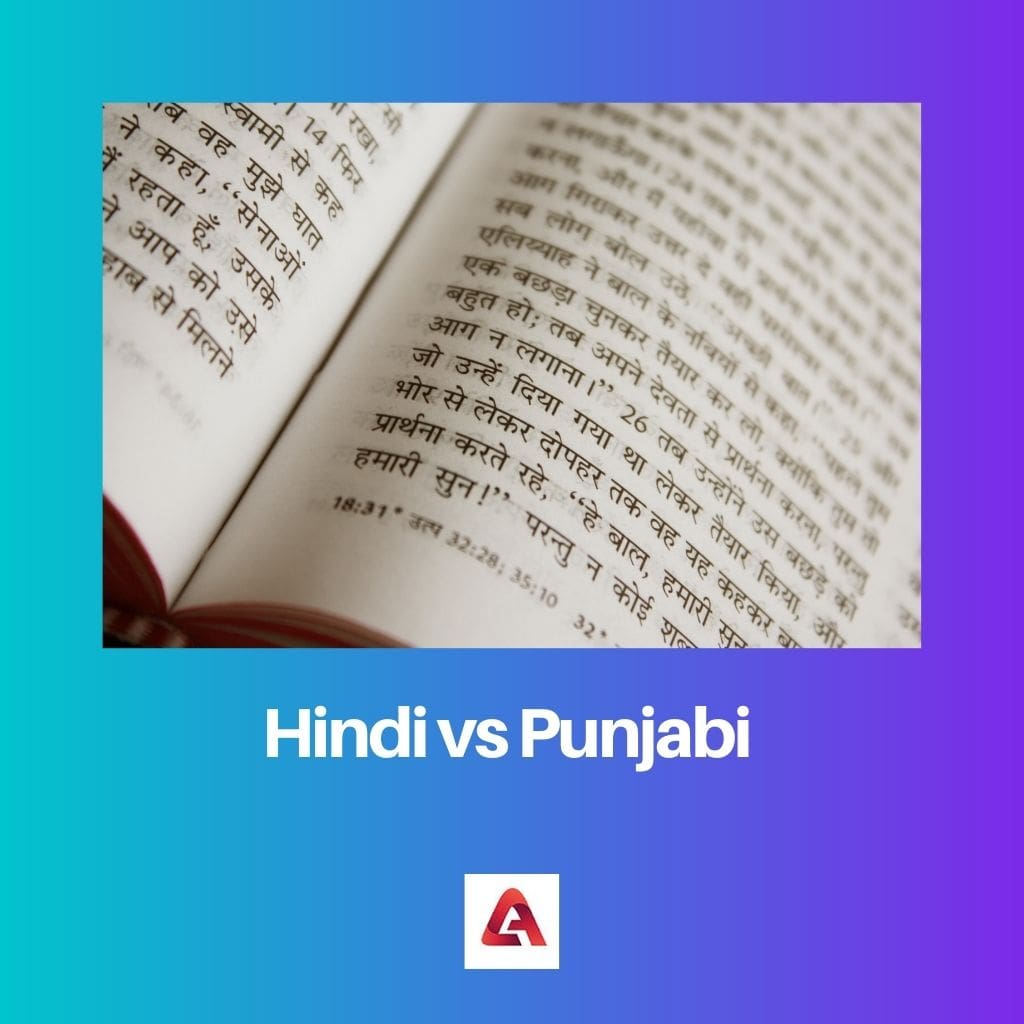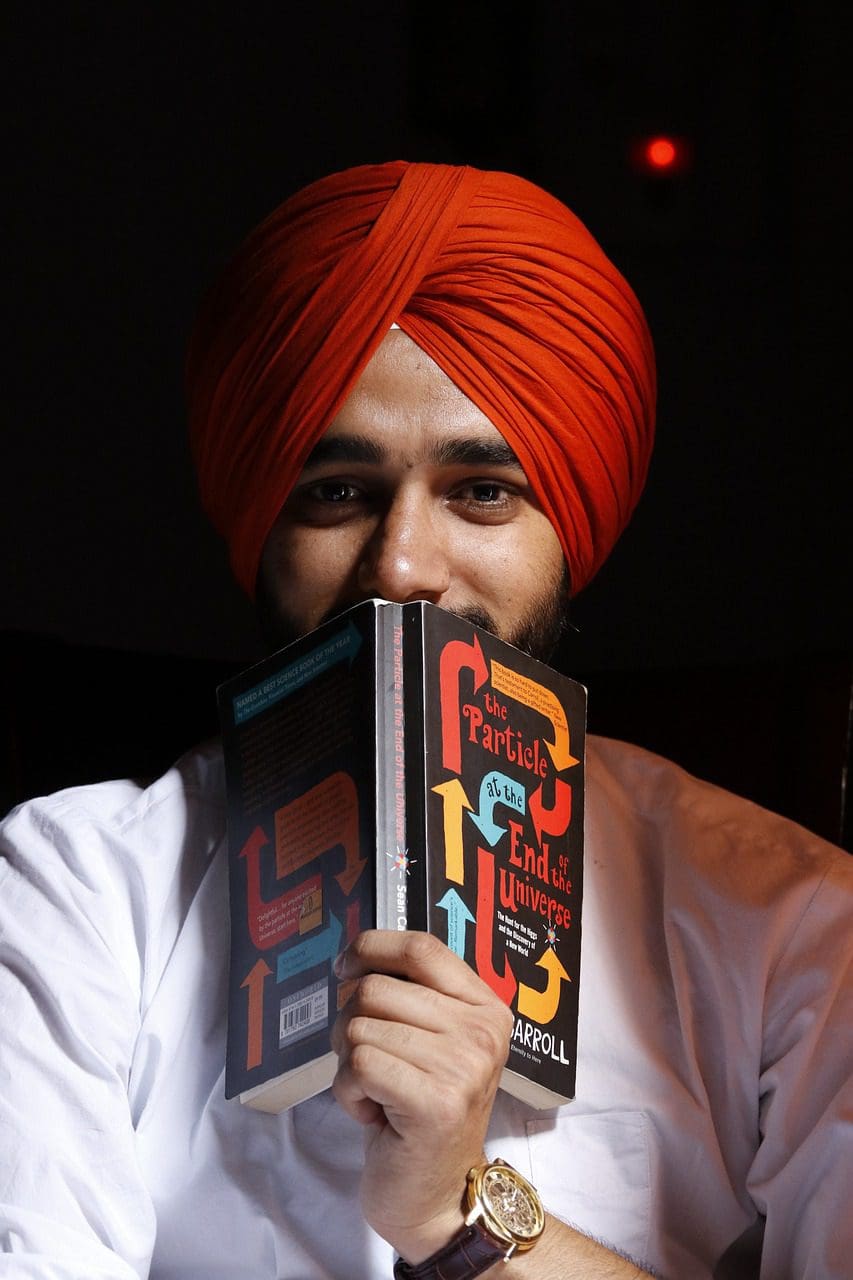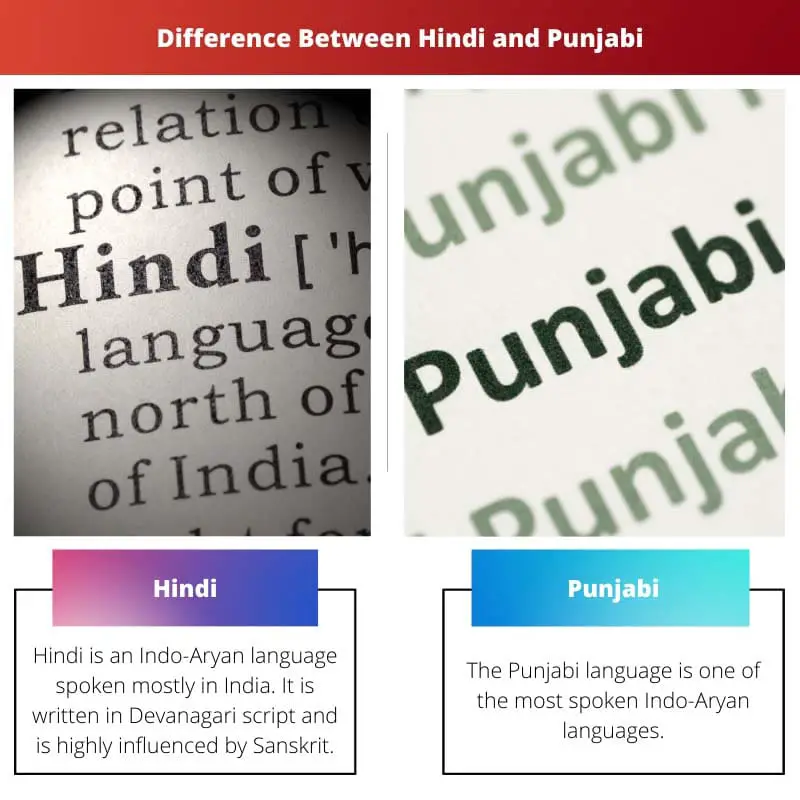Los idiomas son algo que conecta a las personas. Nos permiten comunicarnos entre nosotros.
También nos ayudan a transmitir nuestro mensaje a la otra persona. Los idiomas son muy importantes; uno no podría imaginar comunicarse sin ningún idioma.
India es un país rico en una variedad de idiomas. En la India se hablan 22 idiomas oficiales y dos son Hindi y punjabí.
Puntos clave
- El hindi es un idioma indoario que se habla principalmente en India, con estatus oficial en el país; Punjabi es un idioma indoario que se habla en India y Pakistán, con importantes comunidades de la diáspora en todo el mundo.
- Hindi usa la escritura Devanagari, mientras que Punjabi usa la escritura Gurmukhi, que se deriva de la escritura Brahmi.
- el hindi es el cuarto idioma más hablado del mundo, con más de 600 millones de hablantes; Punjabi tiene más de 100 millones de hablantes en todo el mundo.
hindi vs punjabi
El hindi es el idioma nacional de la India, derivado de la escritura devanagari y contiene 45 alfabetos. 341 millones de personas en el mundo hablan hindi. Punjabi se deriva de la escritura Gurumukhi y contiene 35 alfabetos. Es uno de los 22 idiomas de la India, con 102 millones de hablantes.

Tabla de comparación
| Parámetro de comparación | Hindi | punjabi |
|---|---|---|
| General | Se considera el idioma nacional de la India. | Se cuenta entre uno de los 22 idiomas que se hablan en la India. |
| Guión | Devanagari | Gurumukhi |
| No. de Alfabetos | El número total de alfabetos es 45 en hindi. | El número total de alfabetos es 35 en Punjabi. |
| Natural | Es descendiente directo del sánscrito védico y surgió en el siglo VII EC. | Originalmente surgió como Apabhramsha, un descendiente de Prakrit en el siglo VII d.C. |
| Hablantes nativos | El no. de hablantes de hindi en todo el mundo es de 341 millones. | El no. de hablantes de punjabi en todo el mundo es de 102 millones. |
¿Qué es el hindi?
El hindi es un idioma indoario que se habla principalmente en la India. Está escrito en escritura devanagari y está muy influenciado por el sánscrito.
Originalmente, el hindi se llamaba “hindui”. Es el cuarto idioma más hablado del mundo.
También es uno de los dos idiomas oficiales del Gobierno de la India, junto con el inglés. También es idioma oficial de 9 estados y 3 unión territorios y un idioma oficial adicional en los otros 3 estados.
El hindi se basa en el dialecto "Khari Boli" al norte y al este de Delhi. Hay muchos dialectos del hindi, como Awadhi, Bhojpuri, Bundeli, Chhattisgarhi, Haryanvi, Kanauji, Marwari, Bagheli, Garhwali, Kumayuni y Magahi.
Estos dialectos son los idiomas regionales de la zona de habla hindi de la India.
El hindi es descendiente de los idiomas sánscrito y prakrit. En general, el adjetivo cambia con el número y el género del sustantivo, pero en hindi, el adjetivo no siempre cambia con el cambio del sustantivo, ya que el persa lo influenció.
Además, el número de géneros se ha reducido a dos en hindi, a saber, masculino y femenino. Entonces, el enfoque gramatical del hindi es más simple que el de otros idiomas.
El vocabulario del hindi es bastante extenso. También se inspira en muchas otras lenguas de otros países como Afganistán, Irán, Turquía, etc., cuyas inmigrantes contribuyó a la creación del nuevo hindi y tiene una gran cantidad de palabras inspiradas en el idioma persa, como "divar" wall, "sabun" soap, "kursi" chair, "chador" bedding, "pijama pants", etc.

¿Qué es Punjabi?
El idioma punjabi es uno de los idiomas indoarios más hablados. Los británicos dan la ortografía "Punjabi" y se usa comúnmente, mientras que la ortografía académicamente correcta es "Panjabi".
Hay más de 30 millones de personas que hablan punjabi en la India. También es el idioma oficial de Punjab y uno de los 22 idiomas oficiales de la India.
Aparte de la India, el punjabi también se habla en Pakistán. Hay más de 70 millones de hablantes de punjabi en Pakistán.
La cantidad de personas que hablan punjabi es enorme en Canadá y el Reino Unido.
Punjabi está escrito en escritura Gurumukhi en la India y está asociado con los sikhs. Se escribe de izquierda a derecha, como el hindi en la India. En Pakistán, la escritura se llama Shahmukhi y se escribe de derecha a izquierda, como el urdu.
Los dos países donde Punjabi es más popular son:
- Punjabí en la India: Hay un gran número de hablantes de punjabi en la India. Este idioma lo hablan principalmente las personas sij que viven en Punjab, un estado de la India o estados cercanos. Punjabi está escrito en escritura Gurumukhi y está más influenciado por el hindi y el sánscrito.
- Punjabi en Pakistán: También hay muchos hablantes de punjabi en Pakistán. Usan la escritura Shahmukhi para escribir Punjabi, y Urdu influye en ella.

Principales diferencias entre hindi y punjabi
- Hindi se considera el idioma nacional de India y es uno de los dos idiomas oficiales de India, mientras que Punjabi es uno de los 22 idiomas que se usan oficialmente en India.
- El hindi está escrito en escritura devanagari, mientras que el punjabi está escrito en escritura Gurumukhi y Shahgiri, según el país.
- El número total de alfabetos en hindi es 45. Entre ellos, 35 son "Vyanjan" y 10 son "Swar", mientras que en punjabi solo hay 35 alfabetos.
- El hindi es un descendiente directo del sánscrito védico y surgió en el siglo VII d. C., mientras que el punjabí surgió originalmente como Apabhramsha, un descendiente de Prakrit en el siglo VII d.
- El no. de hablantes de hindi en todo el mundo es de 341 millones, mientras que el no. de hablantes de punjabi en todo el mundo es de 102 millones.

- https://link.springer.com/chapter/10.1007/978-3-319-03844-5_70
- http://pt.learnpunjabi.org/assets/A%20Reference%20Grammar_Final.pdf
Última actualización: 11 de junio de 2023


Emma Smith tiene una maestría en inglés de Irvine Valley College. Ha sido periodista desde 2002, escribiendo artículos sobre el idioma inglés, deportes y derecho. Lee más sobre mí en ella página de biografía.

El contexto histórico y cultural detrás del hindi y el punjabi es realmente fascinante. Es sorprendente ver las influencias del sánscrito, el persa y el prácrito en el hindi, mientras que el punjabi muestra fuertes conexiones con el hindi y el sánscrito, pero mantiene sus propios símbolos y escritura distintivos.
Sin duda, la rica herencia lingüística de estas lenguas es realmente destacable. ¡Es como adentrarse en un tesoro de diversidad lingüística!
Los análisis lingüísticos e históricos presentados aquí despliegan las capas de complejidad dentro del hindi y el punjabi, arrojando luz sobre su profundo significado. Es una exploración profundamente interesante de la narrativa lingüística de la India.
Estoy completamente de acuerdo. Estos conocimientos sobre la evolución y los rasgos distintivos del hindi y el punjabi ejemplifican la naturaleza intrincada y diversa de las lenguas indias, lo que hace que este artículo sea una lectura convincente.
Es increíblemente interesante entender cómo estos dos idiomas, ambos con estatus oficial en la India, tienen diferencias significativas. Dice mucho sobre la diversidad y complejidad no sólo del país, sino de las lenguas indias en general. Aprender sobre ellos es realmente enriquecedor.
¡Sí exactamente! Las variaciones en las escrituras, la cantidad de alfabetos y los orígenes, así como la cantidad de hablantes nativos, realmente muestran cuán únicos son ambos idiomas. Es un testimonio de la complejidad del lenguaje mismo.
La profundidad y el detalle de este artículo proporcionan una comprensión profunda de las complejidades lingüísticas del hindi y el punjabi. Es un gran recurso para obtener información sobre la rica diversidad lingüística de la India.
Absolutamente. Este análisis integral mejora nuestra comprensión de las lenguas indias y ofrece una gran cantidad de conocimientos sobre las intrincadas diferencias y la evolución histórica del hindi y el punjabi.
Una visión general esclarecedora de las complejidades y especificidades del hindi y el punjabi. Subraya la diversa herencia lingüística de la India y ofrece información valiosa sobre estos dos idiomas extraordinarios.
De hecho, la comparación detallada proporciona una rica comprensión de las características únicas y los contextos históricos del hindi y el punjabi, acentuando la riqueza de las lenguas indias.
Absolutamente. Este examen del hindi y punjabi añade profundidad a nuestra comprensión de la naturaleza multifacética de las lenguas indias, fomentando una apreciación más profunda de las dimensiones culturales e históricas.
El artículo presenta un análisis exhaustivo de las diferencias matizadas entre hindi y punjabi, destacando los aspectos culturales, históricos y lingüísticos. Es un testimonio de la naturaleza multifacética de las lenguas indias.
No podría estar mas de acuerdo. La profundidad de la información proporcionada aquí ofrece valiosos conocimientos sobre el intrincado entramado de lenguas indias y la importancia del hindi y el punjabi en el diverso panorama lingüístico del país.
Absolutamente. Explorar las complejidades del hindi y el punjabi muestra la diversidad y riqueza de las tradiciones lingüísticas de la India, lo que la convierte en una lectura verdaderamente esclarecedora.
La comparación exhaustiva entre hindi y punjabi sirve como testimonio de los intrincados matices lingüísticos y culturales que se encuentran en la India. Es una exploración en profundidad de dos lenguajes extraordinarios.
De hecho, la profundidad de la información resumida en este artículo presenta un examen convincente del hindi y el punjabi, que ofrece información valiosa sobre el diverso panorama lingüístico de la India.
El artículo proporciona un análisis profundo de los aspectos lingüísticos e históricos del hindi y el punjabi, destacando sus características únicas y sus contribuciones al diverso tejido cultural de la India.
Absolutamente. Esta comparación exhaustiva enriquece nuestra comprensión del hindi y el punjabi y ofrece una exploración matizada de los intrincados hilos tejidos en las tradiciones lingüísticas de la India.
Es intrigante cómo el hindi y el punjabi han evolucionado con el tiempo, dando como resultado características distintas en términos de escritura, alfabetos y orígenes. Hay mucho más en estos idiomas de lo que parece.
Sin duda, la evolución de estas lenguas realmente ha dado forma a sus identidades únicas, convirtiéndolas en una parte valiosa del patrimonio cultural y lingüístico de la India.
Ese es un muy buen punto. La intrincada evolución del lenguaje refleja la evolución de las narrativas y las historias de las comunidades, y el hindi y el punjabi no son una excepción.
La diversidad lingüística en la India es realmente impresionante. Hay mucho que descubrir y comprender sobre los intrincados detalles de cada idioma y las comunidades con las que están conectados.
De hecho, las complejidades de cada idioma y su importancia para las diferentes regiones y comunidades lo convierten en un tema fascinante para explorar. Es como un viaje por el corazón del tapiz lingüístico de la India.
Absolutamente, la riqueza de las lenguas indias, incluidos el hindi y el punjabi, es un reflejo de las diversas culturas e historias del país. Este artículo arroja luz sobre algunas de las complejidades de manera integral.